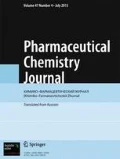Poly(t-butyl methacrylate) (PTBMA) was selected as a doxorubicin carrier for targeted delivery because it can hydrolyze to form water-soluble polymers. A chain-transfer reaction with thioglycolic acid was used. The thioglycolic acid concentration was 1 mass%, at which a polymer with the optimal biocompatibility (molecular mass ~12 kDa, polydispersion index Mw/Mn ≈ 1.5) was obtained. The polymer was chemically modified by a folate vector. The resulting polymer was converted via acid hydrolysis into a water-soluble copolymer. Then, a conjugate of doxorubicin (DOX) with the copolymer of t-butyl methacrylate and methacrylic acid modified by the folate vector on the terminal carboxylates was prepared. The degree of DOX conjugation to the polymer was 62.7 ± 11.8%. DOX was released from the polymer system almost three times faster at pH 4.6 than at pH 7.4. The cytotoxicity of the polymer conjugate was 1.52 μM.






Similar content being viewed by others
References
A. Nori, K. D. Jensen, M. Tijerina, et al., Bioconjugate Chem., 14, 44 – 50 (2003).
A. Gabizon, H. Shmeeda, and Y. Barenholz, Clin. Pharm., 42, 419 – 436 (2003).
H. S. Yoo, K. H. Lee, J. E. Oh, and T. G. Park, J. Controlled Release, 68, 419 – 431 (2000).
Y. Bae, T. A. Diezi, A. Zhao, and G. S. Kwon, J. Controlled Release, 122, 324 – 330 (2007).
M. L. Adams, A. Lavasanifar, and G. S. Kwon, J. Pharm. Sci., 92, 1343 – 1355 (2003).
G. Gaucher, R. H. Marchessault, and J. C. Leroux, J. Controlled Release, 143(1), 2 – 12 (2010).
R. Duncan, Nat. Rev. Cancer, 6(9), 688 – 701 (2006).
O. Zhukova and S. Bulgakova, J. Appl. Pharm. Sci., 6(7), 20 – 26 (2016).
O. Zhukova and S. Bulgakova, Pharm. Chem. J., 48(12), 830 – 834 (2015).
T. Mosmann, J. Immunol. Methods, 65(1–2), 55 – 63 (1983).
F. M. Veronese, O. Schiavon, G. Pasut, et al., Bioconjugate Chem., 16, 775 (2005).
N. Lavignac, J. L. Nicholls, P. Ferruti, and R. Duncan, Macromol. Biosci., 9, 480 – 487 (2009).
Acknowledgments
Equipment at the Common Use Center “Analytical Center IMKh RAS” (Nizhnii Novgorod) was used for the research. We thank Dr. O. V. Kuznetsova, senior scientist in the Laboratory of Physicochemical Analytical Methods IMKh RAS, for assistance in obtaining the IR spectra.
Author information
Authors and Affiliations
Corresponding author
Additional information
Translated from Khimiko-Farmatsevticheskii Zhurnal, Vol. 52, No. 6, pp. 38 – 43, June, 2018.
Rights and permissions
About this article
Cite this article
Zhukova, O.V., Sergeeva, T.F. & Gavrina, A.I. Modified Poly(T-Butyl Methacrylate) as a Doxorubicin Carrier for Targeted Delivery. Pharm Chem J 52, 539–544 (2018). https://doi.org/10.1007/s11094-018-1856-8
Received:
Published:
Issue Date:
DOI: https://doi.org/10.1007/s11094-018-1856-8




